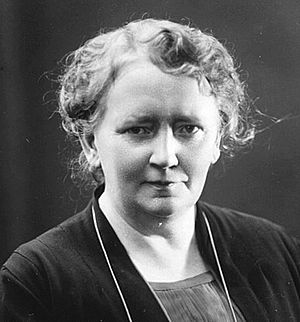Ingibjörg H. Bjarnason facts for kids
Quick facts for kids
Ingibjörg H. Bjarnason
|
|
|---|---|
 |
|
| Member of the Althing | |
| In office 1922–1927 |
|
| Personal details | |
| Born | 14 December 1867 Thingeyri, Iceland |
| Died | 30 October 1941 (aged 73) |
| Political party |
|
Ingibjörg H. Bjarnason (born December 14, 1867 – died October 30, 1941) was a very important woman from Iceland. She was a teacher, a gymnast, and a politician. She is famous for being the first woman ever to become a member of the Althing, which is the parliament (or law-making body) of Iceland. She worked hard to help women get the right to vote and to improve life for women and children.
Contents
Early Life and Learning
Ingibjörg was born in a place called Thingeyri, Iceland, in 1867. She was one of five children. When she was a teenager, her father passed away, and she moved to Reykjavík, the capital city.
In Reykjavík, she went to Kvennaskólinn (the Reykjavík Women's College). She finished college in 1882. After that, she moved to Denmark to study gymnastics. This made her the very first Icelander to study gymnastics abroad!
She came back to Reykjavík in 1893 and started teaching gymnastics at a children's school. In 1903, she returned to the Women's College, but this time as a teacher. By 1906, she became the principal (the head) of the school. She stayed in this important job for 35 years, until she passed away.
Becoming a Politician
Ingibjörg first got involved in the women's suffrage movement in Iceland in 1894. This movement worked to give women the right to vote.
Women Win the Right to Vote
In 1915, Icelandic women finally won the right to vote! This was a huge victory. Ingibjörg was chosen by a women's group to speak to the parliament and give a special speech to celebrate.
She was also chosen to lead a committee. This group raised money to build a hospital called Landspítali (the National University Hospital). It was built to remember the hard work of all the women who fought for the right to vote.
First Woman in Parliament
Ingibjörg led a group called the Women's Slate. This group was an early version of a political party that focused on women's rights.
In 1922, she was elected to the Althing, Iceland's parliament. This was a historic moment because she became the first woman ever to be a member of the Icelandic parliament!
At first, she ran as an independent member, meaning she didn't belong to a specific political party. But in 1924, she joined the Conservative Party. She continued to serve in parliament as a Conservative member until 1927.
During her time in politics, Ingibjörg worked hard to support the rights of women and children. Even though she never married or had children herself, she cared deeply about their well-being.
Later Years and Legacy
After she left politics, Ingibjörg continued to be active in the Icelandic women's liberation movement. In 1930, she helped start and became the first chairperson of a women's organization called Kvenfélagasambands Íslands.
She also served on important committees, like the Landsbanki committee (from 1928 to 1932) and the Icelandic Education Council (from 1928 to 1934). Ingibjörg H. Bjarnason passed away in October 1941.
Remembering Ingibjörg
Many years after her death, people still remembered Ingibjörg's important contributions.
In November 2011, 70 years after she passed away, the Reykjavík City Council decided to build a permanent memorial in Reykjavík to honor her.
In July 2012, a special celebration was held in the Althing (parliament) to mark 90 years since Ingibjörg was first elected. This showed how much her pioneering work was still valued.
See also
 In Spanish: Ingibjörg H. Bjarnason para niños
In Spanish: Ingibjörg H. Bjarnason para niños

